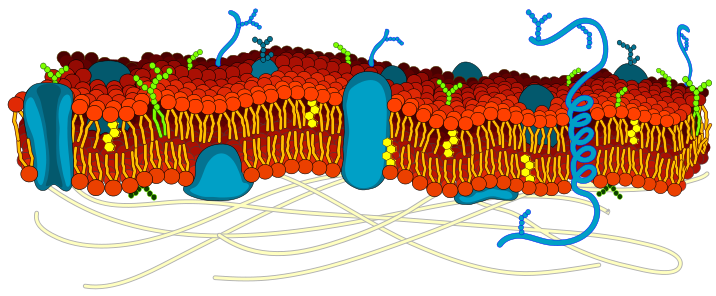Adaptation
One unique organism.
 Pseudomonas
aeruginosa is a very successful bacterium because of the many
different types of adaptations it possesses. For starters,
Pseudomonas aeruginosa is a free-living organism. Since this
bacterium is free-living, its manner of locomotion is through a
single polar flagellum. This flagella helps make it one of the
fastest swimming bacteria known! Picture to the right is a bacteria
with a single flagella- image from
WikiCommons.
Pseudomonas
aeruginosa is a very successful bacterium because of the many
different types of adaptations it possesses. For starters,
Pseudomonas aeruginosa is a free-living organism. Since this
bacterium is free-living, its manner of locomotion is through a
single polar flagellum. This flagella helps make it one of the
fastest swimming bacteria known! Picture to the right is a bacteria
with a single flagella- image from
WikiCommons.
Another way that Pseudomonas aeruginosa has been able to adapt to its environment is through its ability to create a biofilm in environments where the bacterium is often exposed to liquid movement. A biofilm layer is considered an adaptation because it decreases an antibiotics’ ability to eradicate this bacterium in humans or other infected organisms. The formation of a biofilm layer is triggered because of cell-to-cell communication using a quorm sensing system. This system allows for the bacteria to communicate as a population/ group of cells. The cells’ ability to communicate with one another helps them to express their genes in coordination with one another and adapt more effectively to the particular environment they inhabit. In addition to the biofilm formation reducing the effectiveness of antibiotic treatment, the adaptations to the Pseudomonas aeruginosa’s cell membrane also help.
Below: Semi-permeable membrane from
WikiCommons.

Bacteria have a semi-permeable membrane; only hydrophilic molecules
can diffuse across the membrane. Whether or not an antibiotic is
allowed to diffuse across the membrane of a bacterium is determined
by the properties of the protein channels that line the outer
membrane of the bacteria. These channels are what allow the movement
of antibiotics and other molecules across the membrane. In order for
antibiotics to work, they have to be allowed across the membrane
into the cytoplasm. However, since Pseudomonas aeruginosa
does not have a very highly permeable membrane, antibiotics have
greater difficulty crossing the membrane to stop the bacterial
infections they are meant to treat. Generally, the permeability of
substances to a plasma membrane is determined by the types of
channel proteins present in it and the overall pore size of the
channels. However, in Pseudomonas aeruginosa pore size is
very small compared to what is found in other bacteria making it a
key factor in its resistance to antibiotics.
Although there are obvious advantages to having a membrane with low
permeability to antibiotics, there are also costs involved. Low
permeability is not restricted to just antibiotics, other materials
that need to cross the plasma membrane also face restrictions.
Useful materials like nutrients going into the cell and waste
materials diffusing out of the cell are hindered by the same small
pore sizes. But based on the success of Pseudomonas aeruginosa,
its membrane clearly is providing a greater benefit than a
limitation and has contributed to making it an extremely successful
bacterium.
Now let's check out what this bacterium needs in order to survive! (Nutrition)
